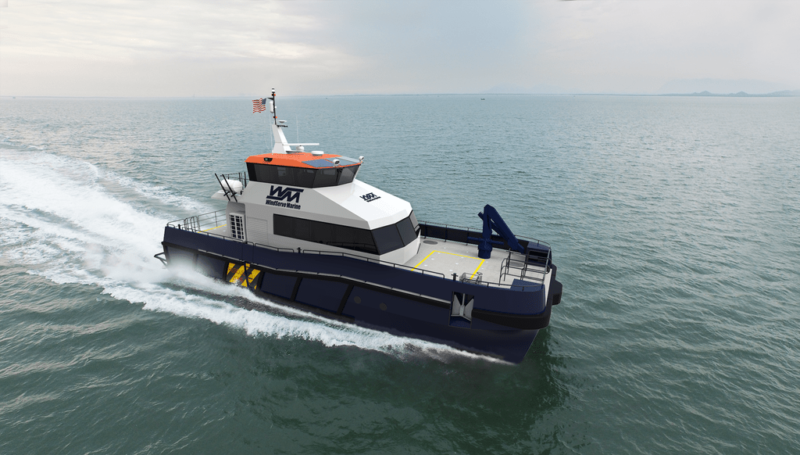Two new U.S.-flag crew transfer vessels (CTVs) for the emerging East Coast offshore wind industry will be built for wind power developer Ørsted and offshore support services provider WindServe Marine LLC, the companies said in a joint announcement Wednesday.
To be built by U.S. Workboats, Hubert, N.C., and Senesco Marine, North Kingstown, R.I., the BMT Group-designed vessels will be the second and third in U.S. service, following the Atlantic Pioneer, built by Blount Boats, Warren, R.I., and servicing Ørsted’s Block Island Wind Farm since 2016.

Crew transfer vessels carry technicians to and from offshore wind energy turbines. Ørsted rendering
U.S. Workboats will deliver its vessel for us on Ørsted’s Coastal Virginia Offshore Wind Project, a pilot project with Dominion Energy for two 6-megawatt turbines, and then deployment to other Ørsted projects in the Northeast.
WindServe is an affiliate of the New York-based Reinauer Group, and the second CTV will be constructed at its affiliate shipyard Senesco Marine, located at Quonset Point, the former Navy base and now a marine industrial hub in North Kingstown.
WindServe worked on the Block Island project for Deepwater Wind, since merged with Ørsted, and is positioned for the company’s Revolution Wind project to be built with transmission provider Eversource off southern New England.
With its Block Island project, Deepwater Wind built local political support by buying and hiring locally. Other wind developers are following that playbook, saying they plan to have vessels built near where they hold federal offshore leases.
“Choosing WindServe to build our CTVs at Senesco will provide locally built vessels and a local operator for the domestic offshore wind industry,” said Thomas Brostrøm, president and CEO of Ørsted North America in announcing the contract. “WindServe Marine’s experience with Jones Act vessel operations and full service shipyard fabrication, coupled with their dedication to the future of green energy, make them a great partner as we expand operations along the East Coast.”
The companies did not release much detail about the vessel design, only describing the catamaran as “a high-speed, custom design from BMT Group … built specifically for East Coast sea conditions.” BMT has extensive offshore wind experience and a large portfolio of offshore wind vessels, with 49 CTVs currently operating in Europe.
Renderings provided by Ørsted appear similar to BMT’s 26 meter (85’) CTVs, which typically can carry up to 36 passengers at service speeds of 25 knots. The boats will be classed by risk management and quality assurance provider DNV-GL
“With over 95 years of experience in the maritime industry, we are committed to offering premier offshore wind support services to the East Coast and look forward to contributing to the future of offshore wind growth,” said Craig Reinauer, President and CEO of the Reinauer Group. “Thanks to Ørsted, this partnership between two global leaders in the offshore wind industry will provide new, sustainable jobs for U.S. workers”.
U.S. Workboats, which specializes in aluminum catamaran construction, has its CTV in progress with delivery anticipated in early 2020. Senesco will start building the second boat in late 2020 for the Revolution Wind project, and it is scheduled for delivery in 2023.
Between the two yards, Ørsted’s order “will help create and sustain in-state jobs for over 40 local tradespeople, engineers and managers,” the companies said.




